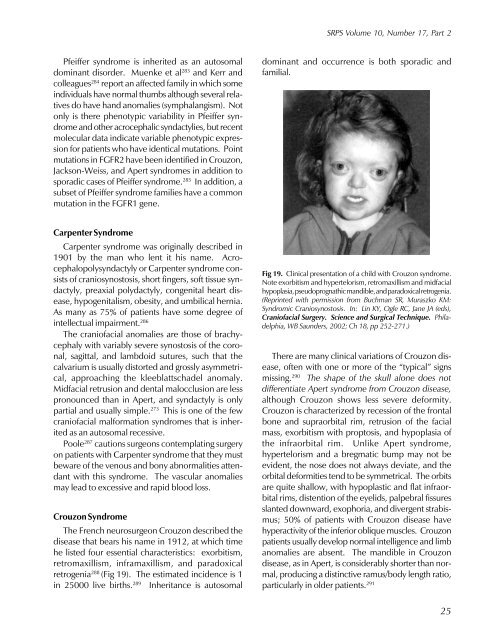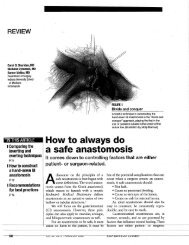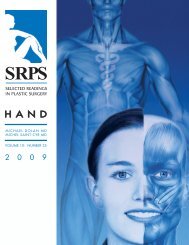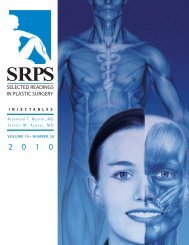Craniofacial Anomalies, Part 2 - Plastic Surgery Internal
Craniofacial Anomalies, Part 2 - Plastic Surgery Internal
Craniofacial Anomalies, Part 2 - Plastic Surgery Internal
Create successful ePaper yourself
Turn your PDF publications into a flip-book with our unique Google optimized e-Paper software.
Pfeiffer syndrome is inherited as an autosomal<br />
dominant disorder. Muenke et al 283 and Kerr and<br />
colleagues 284 report an affected family in which some<br />
individuals have normal thumbs although several relatives<br />
do have hand anomalies (symphalangism). Not<br />
only is there phenotypic variability in Pfeiffer syndrome<br />
and other acrocephalic syndactylies, but recent<br />
molecular data indicate variable phenotypic expression<br />
for patients who have identical mutations. Point<br />
mutations in FGFR2 have been identified in Crouzon,<br />
Jackson-Weiss, and Apert syndromes in addition to<br />
sporadic cases of Pfeiffer syndrome. 285 In addition, a<br />
subset of Pfeiffer syndrome families have a common<br />
mutation in the FGFR1 gene.<br />
Carpenter Syndrome<br />
Carpenter syndrome was originally described in<br />
1901 by the man who lent it his name. Acrocephalopolysyndactyly<br />
or Carpenter syndrome consists<br />
of craniosynostosis, short fingers, soft tissue syndactyly,<br />
preaxial polydactyly, congenital heart disease,<br />
hypogenitalism, obesity, and umbilical hernia.<br />
As many as 75% of patients have some degree of<br />
intellectual impairment. 286<br />
The craniofacial anomalies are those of brachycephaly<br />
with variably severe synostosis of the coronal,<br />
sagittal, and lambdoid sutures, such that the<br />
calvarium is usually distorted and grossly asymmetrical,<br />
approaching the kleeblattschadel anomaly.<br />
Midfacial retrusion and dental malocclusion are less<br />
pronounced than in Apert, and syndactyly is only<br />
partial and usually simple. 273 This is one of the few<br />
craniofacial malformation syndromes that is inherited<br />
as an autosomal recessive.<br />
Poole287 cautions surgeons contemplating surgery<br />
on patients with Carpenter syndrome that they must<br />
beware of the venous and bony abnormalities attendant<br />
with this syndrome. The vascular anomalies<br />
may lead to excessive and rapid blood loss.<br />
Crouzon Syndrome<br />
The French neurosurgeon Crouzon described the<br />
disease that bears his name in 1912, at which time<br />
he listed four essential characteristics: exorbitism,<br />
retromaxillism, inframaxillism, and paradoxical<br />
retrogenia288 (Fig 19). The estimated incidence is 1<br />
in 25000 live births. 289 Inheritance is autosomal<br />
SRPS Volume 10, Number 17, <strong>Part</strong> 2<br />
dominant and occurrence is both sporadic and<br />
familial.<br />
Fig 19. Clinical presentation of a child with Crouzon syndrome.<br />
Note exorbitism and hypertelorism, retromaxillism and midfacial<br />
hypoplasia, pseudoprognathic mandible, and paradoxical retrogenia.<br />
(Reprinted with permission from Buchman SR, Muraszko KM:<br />
Syndromic Craniosynostosis. In: Lin KY, Ogle RC, Jane JA (eds),<br />
<strong>Craniofacial</strong> <strong>Surgery</strong>. Science and Surgical Technique. Philadelphia,<br />
WB Saunders, 2002; Ch 18, pp 252-271.)<br />
There are many clinical variations of Crouzon disease,<br />
often with one or more of the “typical” signs<br />
missing. 290 The shape of the skull alone does not<br />
differentiate Apert syndrome from Crouzon disease,<br />
although Crouzon shows less severe deformity.<br />
Crouzon is characterized by recession of the frontal<br />
bone and supraorbital rim, retrusion of the facial<br />
mass, exorbitism with proptosis, and hypoplasia of<br />
the infraorbital rim. Unlike Apert syndrome,<br />
hypertelorism and a bregmatic bump may not be<br />
evident, the nose does not always deviate, and the<br />
orbital deformities tend to be symmetrical. The orbits<br />
are quite shallow, with hypoplastic and flat infraorbital<br />
rims, distention of the eyelids, palpebral fissures<br />
slanted downward, exophoria, and divergent strabismus;<br />
50% of patients with Crouzon disease have<br />
hyperactivity of the inferior oblique muscles. Crouzon<br />
patients usually develop normal intelligence and limb<br />
anomalies are absent. The mandible in Crouzon<br />
disease, as in Apert, is considerably shorter than normal,<br />
producing a distinctive ramus/body length ratio,<br />
particularly in older patients. 291<br />
25






